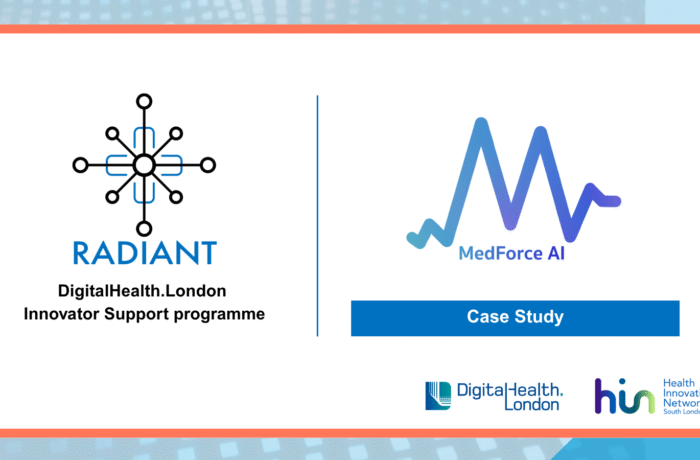Using digital to empower children and young people to self-care in Speech and Language Therapy
Posted on
“With over a million UK children experiencing communication difficulties that are likely to persist into adulthood, could digital therapeutics offer self-management tools to improve functioning and reduce the burden of the underlying impairment?” asks Rafiah Badat, Speech and Language Therapist and Clinical Research Fellow at the Population Health Research Institute, St George’s University Hospitals NHS Foundation Trust. Rafiah is an NHS Digital Pioneer Fellow.
Over 1.4 million children in the UK with a language disorder
It is estimated that 10% of all children, (over 1.4 million children in the UK), present with a language disorder which results in persistent difficulty learning and using language; making it one of the most common childhood disabilities(1). Communication difficulties in the early years can lead to lifelong restrictions in the ability to understand and express wants, needs, thoughts and feelings. Unsurprisingly, co-occurring learning, emotional, psychological and social difficulties are extremely common(2).
Speech and Language Therapists are the primary professionals supporting this population, with the overwhelming majority of Therapists employed by the NHS(3). Despite the significant complexity and prevalence of this client group, survey data indicates that half of all children referred to Speech and Language Therapy have to wait more than six months to get the help they need with 85% of parents reporting ongoing issues with access to Speech and Language Therapy(4).
Digital therapy tools for the management of communication needs
One option for improving access to support is for Speech and Language Therapists to provide digital therapy tools for the management of communication needs which, once modelled, can be accessed by children as needed under parental guidance. The digital intervention could initially take place alongside and in addition to the more traditional face to face care model with a gradual move towards more remote monitoring for the children who respond well to the technology. The fact is that a substantial number of children with communication difficulties demonstrate as much or greater motivation to engage with digital technology as their typically developing peers due to the medium making socio-emotional communication more manageable(5). Unlike the traditional pre-published paper-based therapy programmes, digital tools can also be more readily personalised to meet the needs and interests of the individual child.
Whilst the introduction of digital therapeutics to clients by UK Speech and Language Therapists is in its relative infancy, studies from the USA and Australia show its potential to encourage more independent management of needs. Research involving children with a range of communication difficulties has demonstrated that using mobile technology, for example tablets can provide multisensory language-learning opportunities, increase autonomous learning, promote engagement with peers as well as adults and provide greater opportunities for communication(6). More specifically, findings have demonstrated greater language gains when children independently access digital techniques for language promotion in comparison to the more static, paper-based strategies(6).
Digital interventions provide children with lifelong skills
So, we can see that the use of digital interventions to support communication difficulties can provide children with lifelong skills, allowing them to become proficient in using technology to support independence in language and communication and more generally. There is good reason for Speech and Language Therapists to consider addressing potential barriers with factors such as time, confidence, and digital-familiarity in order to achieve the clinical gains and improved patient outcomes that could potentially be obtained from introducing digital therapeutics.
References
- Norbury, C.F., Gooch, D., Wray, C., Baird, G., Charman, T., Simonoff, E., Vamvakas, G. and Pickles, A. (2016) The impact of nonverbal ability on prevalence and clinical presentation of language disorder: evidence from a population study. Journal of Child Psychology and Psychiatry, 57(11), pp.1247-1257
- Pinborough-Zimmerman, J., Satterfield, R., Miller, J., Bilder, D., Hossain, S., & McMahon, W. (2007). Communication disorders: Prevalence and comorbid intellectual disability, autism, and emotional/ behavioral disorders. American Journal of Speech-Language Pathology, 16(4), 359-367.
- Pring, T., Flood, E., Dodd, B., and Joffe, V., (2012) The working practices and clinical experiences of paediatric speech and language therapists: a national UK survey. International Journal of Language & Communication Disorders, 47(6), 696-708
- Bercow, J. (2018). Bercow: Ten Years On: An independent review of provision for children and young people with speech, language and communication needs in England. Published by I CAN the children’s communication charity, and the Royal College of Speech and Language Therapists (RCSLT). bercow10yearson.com
- Blom, E., Van Dijk, C., Vasić, N., Van Witteloostuijn, M., and Avrutin, S. (2017) Textese and use of texting by children with typical language development and Specific Language Impairment. Computers in Human Behavior, 66, 42-51
- Draper Rodríguez, C., Strnadová, I., & Cumming, T. (2014). Using iPads with students with disabilities: Lessons learned from students, teachers, and parents. Intervention in School and Clinic, 49(4), 244-250.
- Lowman, J. J., and Dressler, E. V., (2016) Effects of explicit vocabulary videos delivered through iPods on students with language impairments. Journal of Special Education Technology, 31(4), 195-206.


